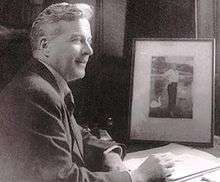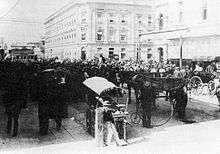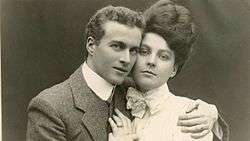Lionel Logue
| Lionel Logue CVO | |
|---|---|
 Lionel Logue c. 1930 | |
| Born |
26 February 1880 College Town, Adelaide, South Australia |
| Died |
12 April 1953 (aged 73) London, England, UK |
| Nationality | Australian |
| Fields | Speech and elocution |
| Institutions |
British Society of Speech Therapists Royal College of Speech Therapists |
| Known for | Speech therapist to King George VI |
| Spouse |
Myrtle Gruenert (m. 1907–45; her death) |
| Children | 3 |
Lionel George Logue, CVO (26 February 1880 – 12 April 1953) was an Australian speech and language therapist and amateur stage actor who successfully treated, among others, King George VI, who had a pronounced stammer.
Early life and family
Lionel George Logue was born in College Town, Adelaide, South Australia, the oldest of four children. His grandfather Edward Logue, originally from Dublin, set up Logue's Brewery in 1850, which, after Edward's death in 1868, would merge with the South Australian Brewing Company.[1] His parents were George Edward Logue, an accountant at his grandfather's brewery who later managed the Burnside Hotel and Elephant and Castle Hotel, and Lavinia Rankin.[2] Although not a Catholic himself, he was reportedly related to Michael Logue, who was the Roman Catholic Archbishop of Armagh and Primate of All Ireland in the late 19th and early 20th centuries.[3]
He attended Prince Alfred College between 1889 and 1896. Unable to decide what to study, Logue came across Longfellow's The Song of Hiawatha:[4]
Then lagoo, the great boaster,
He the marvellous story-teller,
He the traveller and the talker,
He the friend of old Nokomis,
Made a bow for Hiawatha— Henry Wadsworth Longfellow
What inspired Logue was the rhythm and he decided to put his interest in voices to good use.[2] After leaving school at sixteen, he received elocution training from Edward Reeves. Reeves had moved to Adelaide in 1878 and taught elocution to his pupils by day and gave popular recitals to audiences in Victoria Hall by night. Logue worked for Reeves as a secretary and assistant teacher from 1902, while studying music at the University of Adelaide's Elder Conservatorium. While working for Reeves, Logue began to give recitals of his own for which he was praised for his "clear, powerful voice."[5]

After his father died on 17 November 1902, Logue set up his own practice as a teacher of elocution. By 1904, he had gained a good reputation and was receiving praise from the local newspapers.[6] However, he decided to take a contract with an engineering firm some 2,000 kilometres (1,200 mi) westward in Kalgoorlie, Western Australia, installing an electricity supply at a gold mine.[6][7]
Professional career
His professional career began in Perth, where, in addition to teaching elocution, acting, and public speaking, he put on plays and recitations, and also founded a club for public speakers. He was also involved with Perth's Young Men's Christian Association and schools such as Methodist Ladies' College, Loreto Convent, Scotch College, Perth Technical School, and Claremont Teachers College.
In 1911, Logue and his wife set out on a tour of the world to study methods of public speaking. Later he started a practice in which he developed treatments for Australian war veterans who had impaired speech because of shell-shock in World War I.[8] In addition to physical exercises, which helped with patients' breathing, Logue's distinctive therapy emphasised humour, patience, and "superhuman sympathy".
In 1924, Logue took his wife and three sons to England, ostensibly for a holiday. Once there, he took jobs teaching elocution at schools around London. In 1926, Logue opened a speech-defect practice at 146 Harley Street. It was there that the Duke of York, the future King George VI, sought Logue's help. Logue used fees paid to him by wealthy clients to subsidise patients who could not afford to pay.[9] Logue became a founding fellow of the Royal College of Speech and Language Therapists in 1944.[10]
Treatment of King George VI
Before he ascended the throne, Prince Albert, Duke of York, dreaded public speaking because he suffered from a severe stammer.[11] His closing speech at the British Empire Exhibition at Wembley on 31 October 1925 proved an ordeal for speaker and listeners alike. The experience left the Duke resolved to find a way to manage his stammer, so he engaged Logue in 1926.[12][13] John 'Jock' Murray VI was successfully treated for a stammer by Mr Logue, and it was through a connection to a friend, Lord Stamfordham, that Logue was introduced to the Duke of York.[14]
Diagnosing poor co-ordination between the Duke's larynx and thoracic diaphragm, Logue prescribed a daily hour of vocal exercises. Logue's treatment gave the Duke the confidence to relax[15] and avoid tension-induced muscle spasms. As a result, he suffered only the occasional hesitancy in speech. By 1927, he was speaking confidently and managed his address at the opening of the Old Parliament House in Canberra[16] without stammering.[17]
Logue worked with the Duke through the 1930s and 40s. He used tongue-twisters[18] to help his patient rehearse for major speeches, his coronation, and his radio broadcasts to the British Empire throughout the Second World War. The two men remained friends until the King's death.
Honours
In 1944, King George VI appointed Logue a Commander of the Royal Victorian Order (CVO), elevating him from Member of the Order (MVO), which was conferred upon Logue at the time of George VI's Coronation.[13][19][20][21]
King George VI died on 6 February 1952. On 26 February 1952, Logue wrote to the late king's consort, Queen Elizabeth The Queen Mother, stating that since 1926 the king:
| “ | ...honoured me, by allowing me to help him with his speech, and no man ever worked as hard as he did, and achieved such a grand result. During all those years you were a tower of strength to him and he has often told me how much he has owed to you, and the excellent result could never have been achieved if it had not been for your help. I have never forgotten your gracious help to me after my own beloved girl [Logue's wife, Myrtle] passed on.[22] | ” |
The Queen Mother replied two days later:
| “ | ...I think that I know perhaps better than anyone just how much you helped the King, not only with his speech, but through that his whole life and outlook on life. I shall always be deeply grateful to you for all you did for him. He was such a splendid person and I don't believe that he ever thought of himself at all. I did so hope that he might have been allowed a few years of comparative peace after the many anguished years he has had to battle through so bravely. But it was not to be.[23][24] | ” |
Personal life

Logue married Myrtle Gruenert, a 21-year-old clerk, at St George's Anglican Cathedral, Perth, on 20 March 1907.[25] They had three sons, Valentine, one of the most distinguished neurosurgeons of his generation (he was trained at King's College London and St George's Hospital),[26] Laurie, and Anthony.[27]
He was a Freemason, initiated, passed, and raised in 1908, and became Worshipful Master in 1919; he was a member of St. George's Lodge (now J.D. Stevenson St. George's Lodge No.6, Western Australian Constitution).[28][29]
He lived in a 25-room Victorian villa called Beechgrove in Sydenham from before 1933 until about 1940.[30][31]
Death
Logue was predeceased by his wife Myrtle in June 1945.[32] Logue himself died in London on 12 April 1953, aged 73. His funeral was held on 17 April in Holy Trinity, Brompton before his body was cremated.[33] The Queen and the Queen Mother both had representatives attend the funeral service.[34]
In popular culture
Logue's grandson, Mark, wrote a book with Peter Conradi about his grandfather's relationship with the Duke of York, who later became King George VI, entitled The King's Speech: How One Man Saved the British Monarchy.[35] The short title was used for the 2010 British film The King's Speech, a historical drama written by David Seidler, in which Logue was played by Geoffrey Rush and his patient by Colin Firth. In February 2011, The King's Speech won four Academy Awards, including Best Picture and Best Actor for Colin Firth.
See also
References
- Notes
- ↑ Logue, Mark; Peter Conradi (2010). The King's Speech: How One Man Saved the British Monarchy. Quercus, London. p. 15. ISBN 978-0-85738-110-1.
- 1 2 Logue and Conradi, p. 16.
- ↑ Taoiseach Enda Kenny on The Late Late Show, Friday, 27 May 2011
- ↑ Longfellow, Henry Wadsworth (1876). The poetical works of Henry Wadsworth Longfellow. Boston: Osgood & Co. p. 148.
- ↑ Logue and Conradi, p. 18.
- 1 2 Logue and Conradi, p. 19.
- ↑ Edgar, Suzanne. "Logue, Lionel George (1880–1953)". Australian Dictionary of Biography. Australian National University. Retrieved 17 December 2010.
- ↑ "Stuttering and The King's Speech". The Stuttering Foundation. Retrieved 17 December 2010.
- ↑ Logue and Conradi, p. 39.
- ↑ Bowen, Caroline. "Lionel Logue: A Pioneer in Speech-Language Pathology". The Asha Leader. Retrieved 1 May 2011.
- ↑ Drabble, Margaret. "Public Speech and Public Silence". The British Stammering Association. Retrieved 17 December 2010.
- ↑ Bousfield, Arthur; Toffoli, Garry (2002). Queen Elizabeth the Queen Mother, 1900–2002: The Queen Mother and Her Century. Dundurn Group (CA). p. 50. ISBN 1-55002-391-8.
- 1 2 "Mr. Lionel Logue". The Times. London. 13 April 1953. p. 8.
- ↑ BBC, Note reveals story behind King's speech film, 1 March 2011.
- ↑ Erickson, Carolly (2005). Lilibet: An Intimate Portrait of Elizabeth II. St. Martin's Press. p. 15. ISBN 0-312-33938-0.
- ↑ National Film and Sound Archive: Official Opening of Canberra by His Royal Highness the Duke of York 1937
- ↑ Shawcross, William (2009). The Queen Mother: The Official Biography. Knopf Doubleday Publishing Group. p. 460. ISBN 1-4000-4304-2.
- ↑ According to Sreedharan (2007), p. 100, two of the tongue twisters were "Let's go gathering healthy heather with the gay brigade of grand dragons", and "She sifted seven thick-stalked thistles through a strong, thick sieve".
- ↑ The London Gazette: (Supplement) no. 34396. p. 3084. 11 May 1937. Retrieved 27 February 2011.
- ↑ The London Gazette: (Supplement) no. 36544. p. 2571. 2 June 1944. Retrieved 27 February 2011.
- ↑ David Seidler (screenwriter) (2010). The King's Speech (Motion picture). UK: See-Saw Films. Event occurs at 1:51:43.
- ↑ Logue to Queen Elizabeth, the Queen Mother, 26 February 1952, The National Archives (U.K.)
- ↑ The Queen Mother to Lionel Logue, 28 February 1952, The National Archives (U.K.)
- ↑ Walker, Tim (6 December 2010). "Queen Elizabeth's posthumous endorsement of Lionel Logue". The Daily Telegraph. London. Retrieved 2 June 2013.
- ↑ Logue and Conradi, p. 20.
- ↑ "Logue, Valentine (1913 - 2000)".
- ↑ Logue and Conradi, p. 35.
- ↑ "Film "The King's Speech"". Mastermason.com Forums. 18 February 2011. Retrieved 26 March 2011.
- ↑ "The King's Freemasonry". Freemasonry Today magazine. March 2011. Retrieved 21 February 2014.
- ↑ "Beachgrove, 111 Sydenham Hill". www.sydenham.org.uk. Retrieved 16 February 2011.
- ↑ Jack, Ian (15 January 2011). "Lionel Logue and the king". The Guardian. London. Retrieved 16 February 2011.
- ↑ "Lionel Logue – At the End of his Life". Awesome Stories. Retrieved 2 June 2013.
- ↑ "Deaths". The Times. London. 14 April 1953. p. 1.
- ↑ "Court Circular". The Times. London. 18 April 1953. p. 8.
- ↑ Logue, Mark; Peter Conradi (2010). The King's Speech: How One Man Saved the British Monarchy. Quercus, London. ISBN 978-0-85738-110-1.
- Sources
- Australian Dictionary of Biography
- BBC Interview with Mark Logue (4 January 2011), about finding Lionel Logue's notes
- "Chance Meeting Led to Cure of King's Stutter", The Sydney Morning Herald (Monday, 11 February 1952), p. 3.
- Darbyshire, T., The Duke of York: an intimate and authoritative life story of the second son of Their Majesties the King and Queen by one who has had special facilities, and published with the approval of His Royal Highness, Hutchinson, (London), 1929
- Logue, Mark; Conradi, Peter (November 2010), The King's Speech: How One Man Saved the British Monarchy, London: Quercus, ISBN 0-85738-110-5 (Note: co-author Mark Logue is a grandson of the subject, Lionel Logue).
- Moses, E., & E. M. Foley, "The King's Speech", The Sydney Morning Herald, (Thursday, 24 December 1936), p. 5.
- Rhodes James, Robert (1998), A Spirit Undaunted: The Political Role of George VI, London: Little, Brown and Co, ISBN 0-316-64765-9
- St. Claire, M. "An Australian Cures Defect in King's Speech", The Australian Women's Weekly, (Saturday, 2 January 1937), p. 12
External links
- "Lionel Logue 'never swore in front of King George VI'", BBC Radio Leicester
- Bowen, Caroline (2002). Lionel Logue: Pioneer speech therapist. Retrieved 1 January 2011
- Hutchinson, Norman C. (2010). Lionel Logue: the King's Mentor, self-published, Box Hill South, Victoria, Australia
- Letter sent by Logue to George VI, Royal College of Speech and Language Therapists archives
- Rare photo of Lionel Logue near the end of his life, from the UK National Archives